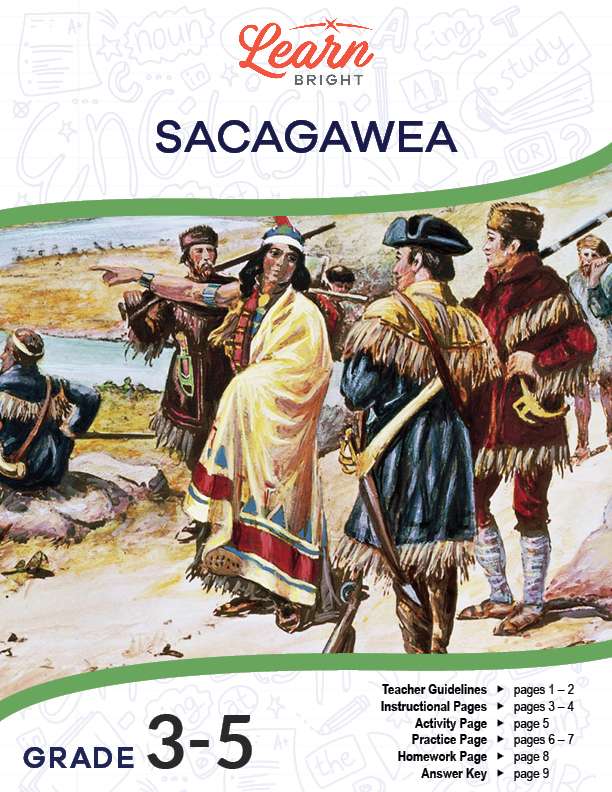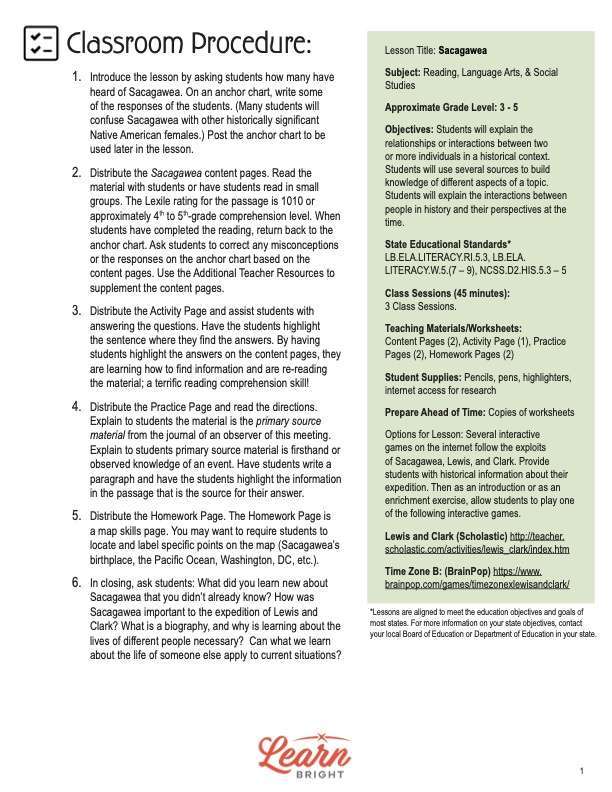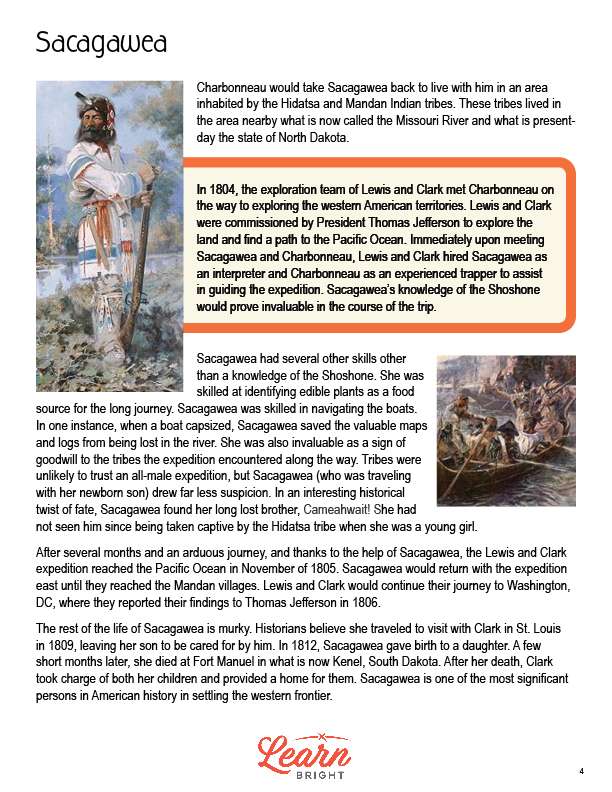Description
What our Sacagawea lesson plan includes
Lesson Objectives and Overview: Sacagawea is unique in that it provides instruction in multiple fields: literacy, history, and writing. Students will discover much about this famous historical figure. In addition, however, they will learn how to analyze information for several different purposes. The will examine primary sources, write an opinion, and even use map skills. This lesson is for students in 3rd grade, 4th grade, and 5th grade.
Classroom Procedure
Every lesson plan provides you with a classroom procedure page that outlines a step-by-step guide to follow. You do not have to follow the guide exactly. The guide helps you organize the lesson and details when to hand out worksheets. It also lists information in the green box that you might find useful. You will find the lesson objectives, state standards, and number of class sessions the lesson should take to complete in this area. In addition, it describes the supplies you will need as well as what and how you need to prepare beforehand. The supplies you will need for this lesson are pencils, pens, highlighters, and internet access.
Options for Lesson
Included with this lesson is an “Options for Lesson” section that lists a number of suggestions for activities to add to the lesson or substitutions for the ones already in the lesson. The only suggested addition to this lesson is to allow students to play one of the interactive games listed in the lesson.
Teacher Notes
The teacher notes page includes a paragraph with additional guidelines and things to think about as you begin to plan your lesson. This page also includes lines that you can use to add your own notes as you’re preparing for this lesson.
SACAGAWEA LESSON PLAN CONTENT PAGES
Sacagawea
The Sacagawea lesson plan includes two pages of content. Sacagawea was born in May 1788, in Lemhi County, ID. She died on December 20, 1812, in Kenel, South Dakota. She married Toussaint Charbonneau in 1804. When she died, they buried her in Sacajawea County, Fort Washakie, WY. Sacagawea had two children, Jean Baptiste Charbonneau and Lizette Charbonneau.
We don’t know what exactly Sacagawea looked like, because we didn’t have photography yet. However, many different artists have tried to showcase her on coins, statues, and more. We have many different monuments and historical markers commemorating her life. Sacagawea has a fascinating and important biography.
She was born in 1788 in what is now Lemhi County, Idaho and was the daughter of a Shoshone chief. In 1788, the United States had only eleven states, all located east of the Mississippi. This was also only 12 years after the United States had gained its independence from Great Britain.
We don’t know a lot about Sacagawea’s early life, but historians think that an enemy tribe, the Hidatsa Indian tribe, captured her some time around her twelfth birthday. They traded or sold her to a French-Canadian fur trapper named Toussaint Charbonneau. This was a very profitable business at this time, and French trappers in particular usually dealt in high-quality furs due to their good relationships with native tribes. Sacagawea later married Charbonneau.
Charbonneau took Sacagawea to live with him in an area mostly populated by the Hidatsa and Mandan Indian tribes, near what we now call the Missouri River in North Dakota.
Lewis and Clark Expedition
Explorers Lewis and Clark met Charbonneau in 1804, while on their way to explore the western territories. President Thomas Jefferson had commissioned them to find a path to the Pacific Ocean. Lewis and Clark hired Sacagawea as an interpreter and Charbonneau as a trapper on the expedition. Sacagawea’s connections to the Shoshone people was very helpful on the expedition.
Sacagawea had many skills. She could identify edible plants and navigate on boats. She saved valuable maps and other documents from being lost in the river when their boat capsized. They also used her as a sign of goodwill to the tribes they encountered. Tribes found her presence, as a woman with a baby, comforting and less suspicious than an all-male expedition. On the trip, Sacagawea also found her long-lost brother, Cameahwait, who she had not seen since she was a young girl.
The Lewis and Clark expedition reached the Pacific Ocean after many months of traveling, in November 1809, thanks in part to Sacagawea’s help. Sacagawea traveled back east with the expedition, stopping at the Mandan villages. Lewis and Clark continued on to Washington, D.C., where they gave Thomas Jefferson their report in 1806.
We don’t know much about the rest of Sacagawea’s life. Historians think she might have traveled to visit Clark in St. Louis in 1809, and may have left her son with him for a time. She had a daughter in 1812 and then died a few months later at Fort Manuel, in what is now South Dakota. Clark took care of both of her children after her death. We remember her today for her role in settling the western frontier.
SACAGAWEA LESSON PLAN WORKSHEETS
The Sacagawea lesson plan includes three worksheets: an activity worksheet, a practice worksheet, and a homework assignment. You can refer to the guide on the classroom procedure page to determine when to hand out each worksheet.
COMPREHENSION QUESTIONS ACTIVITY
The activity requires students to answer questions based on what they learned in the lesson. The first four questions involve simple facts. The last three, however, require students to analyze the information they learned. They have to discover their own ideas and opinions on what they think. The answers may widely vary among the students.
EXPLAIN THE PASSAGE PRACTICE WORKSHEET
For the practice, students will read an excerpt from one of the journals of Lewis and Clark. After reviewing and analyzing the passage, students must explain in their own words what they think it means.
SACAGAWEA HOMEWORK ASSIGNMENT
Students will need to visit the interactive map at the link that this worksheet provides or use other resources to complete the assignment. They will trace the journey of Sacagawea, Lewis, and Clark across the United States on the map. They must label places that they read about in the lesson.
Worksheet Answer Keys
This lesson plan includes answer keys for the practice worksheet and the homework assignment. If you choose to administer the lesson pages to your students via PDF, you will need to save a new file that omits these pages. Otherwise, you can simply print out the applicable pages and keep these as reference for yourself when grading assignments.









